It’s 4:15 a.m. on a Thursday when Heewon Kim (C’22) jolts awake to the first of nine alarms. Groggy from two hours of sleep (better than last semester, when she used to pull all–nighters), she tiptoes around her still–slumbering roommate. The sky is still pitch black as she gets ready for the day and heads to her hall lounge, her “Warrior Knowledge” manual clutched in her hand.
I am an American Airman. I am a Warrior. I have answered my nation’s call…
Kim repeats the Airman’s Creed to herself under her breath. The hefty “Warrior Knowledge” handbook is jam–packed with mission statements, honor codes, and core knowledge about the Air Force. She must carefully memorize this handbook in preparation for weekly oral quizzes or risk having her entire flight—military unit—be scolded.
Kim dashes out of English House at 5:30 a.m., barely making it to the carpool she shares with the other Air Force ROTC cadets. They drive from Penn to Saint Joseph’s University (SJU), which sits on the northwestern edge of Philadelphia. Most SJU students are still in their beds as the group enters campus. The classroom is filled with people marching and practicing drill exercises before AS100, their aerospace studies class.
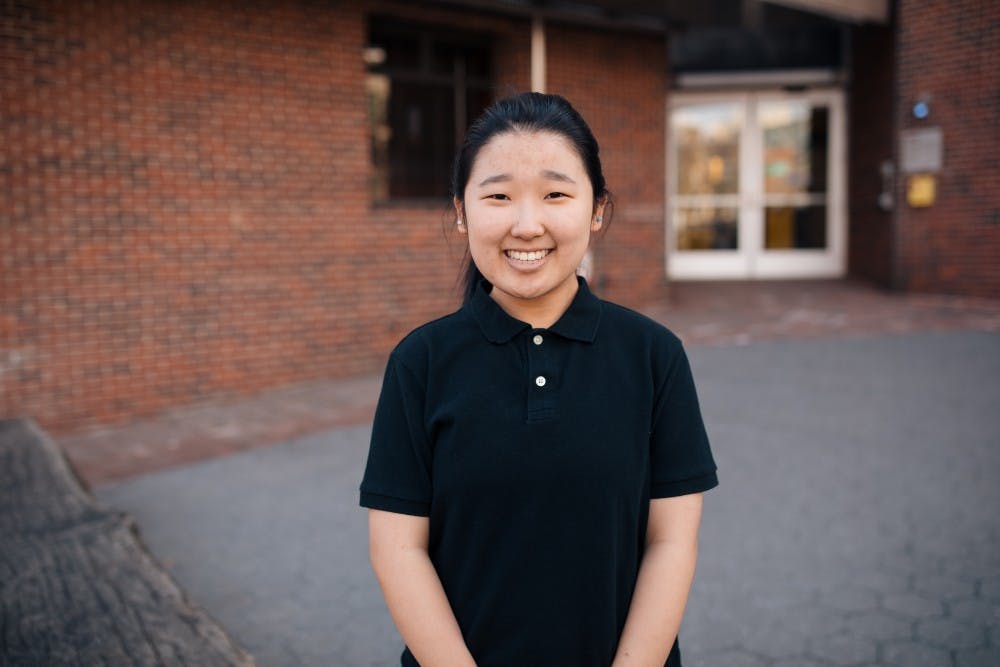
Heewon Kim, Air Force ROTC
ROTC, or Reserve Officer Training Corps, students at Penn are midshipmen in Penn’s Naval ROTC (NROTC) unit housed on–campus in the Hollenback Center, as well as cadets in Air Force ROTC (AFROTC) and Army ROTC (AROTC), housed at SJU and Drexel University, respectively.
Among members of this social and professional subculture are Reagan Bracknell (C’21) and Connor Blend (W’22), midshipmen in NROTC, who, on graduation weekend, will be commissioned as naval officers and owe five years of service to the U.S. Navy. Junney Kang (C’19) and Jack Stinger (W’20) are two of approximately eight Penn cadets in Drexel’s AROTC.
They will have an eight–year commitment either on active duty or in a reserve military force like the National Guard or the Army Reserve. Only three cadets make up the Penn contingent of SJU’s AFROTC unit, including Kim; if they are selected for Field Training and successfully complete the Professional Officer Course (POC) during their junior and senior years, they will be contracted for four years post–graduation.
Bracknell, Blend, Kang, Stinger, and Kim—ROTC peers refer to each other by last name, in true military fashion—undergo intensive training for their eventual role as commissioned officers.
ROTC students live dual lives—sometimes traipsing around campus in full uniform, other times presenting just like their non–ROTC friends, roommates, and classmates. Caught between two worlds, they balance traditional student life with preparing for life in the Armed Forces. And while the ROTC experience is not the same for everyone, students are all united by one important fact. While Penn undergraduates spend four years searching for internships and jobs, ROTC students have already committed themselves to a different path: serving in the U.S. military upon graduation.
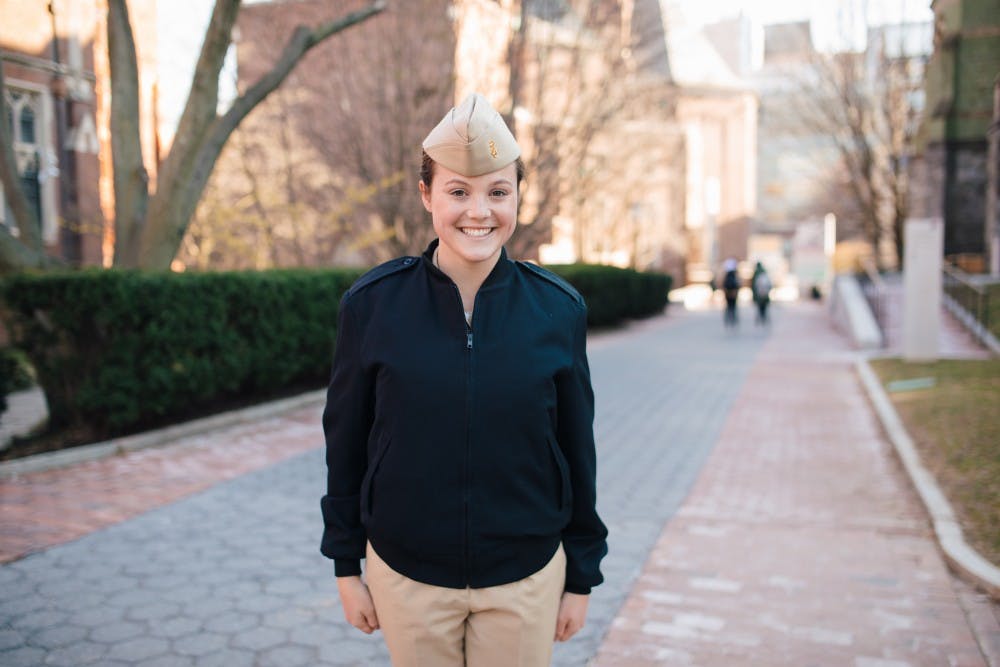
Reagan Bracknell, Naval ROTC
Most of the ROTC students interviewed didn't decide to join ROTC until their junior year of high school. The early wake–ups and training commitments notwithstanding, legally committing to years of military service requires serious deliberation.
Bracknell rushes to this interview directly from the Hollenback Center, still wearing her Navy cap. She’d been into sports in high school—diving—and only decided to pursue ROTC when that didn’t work out. “I realized I wanted to serve in some capacity after college. Once I realized I had a strong interest in international affairs, and particularly the affairs of the Middle East, I realized: what better way to serve than the military?”
A Modern Middle Eastern Studies major and Legal Studies and History minor, Bracknell is interested in international law. She says, “A lot of the perception that the military has now is people thinking that it doesn’t act ethically and that we impose on the sovereignty of nations and people… I thought it was important for people who are passionate about justice, law, and ethics to join.”

Others have planned this path for a long time. Kang’s father joined ROTC in college but quit, and Kang wanted to complete it on his father’s behalf and serve his country. “I wanted to be self–sufficient and not rely on my parents for tuition, and become more disciplined,” he explains.
Stinger, a self–described “military brat,” grew up in a family with a long history of military service. “[ROTC] was something I wanted to do since day zero. I wanted to jump out of planes and get paid to do it by the US Army.” Besides being given a management role right out of college, “The real reason is service… We don’t do it for recognition… I want to use the talents that I’ve been given and whatever advantages I’ve had to help save lives and help accomplish our nation’s mission.”
For many, the tuition scholarships that ROTC grants are a major incentive. Branches of ROTC have different levels of scholarships, including full–tuition scholarships, which applicants compete for prior to college. Alternatively, one can join ROTC and then try to compete for a scholarship after arriving to Penn, although this is more rare. Each interviewed student mentions that they’re on a scholarship; Bracknell and Stinger say they wouldn’t be able to attend Penn without it.
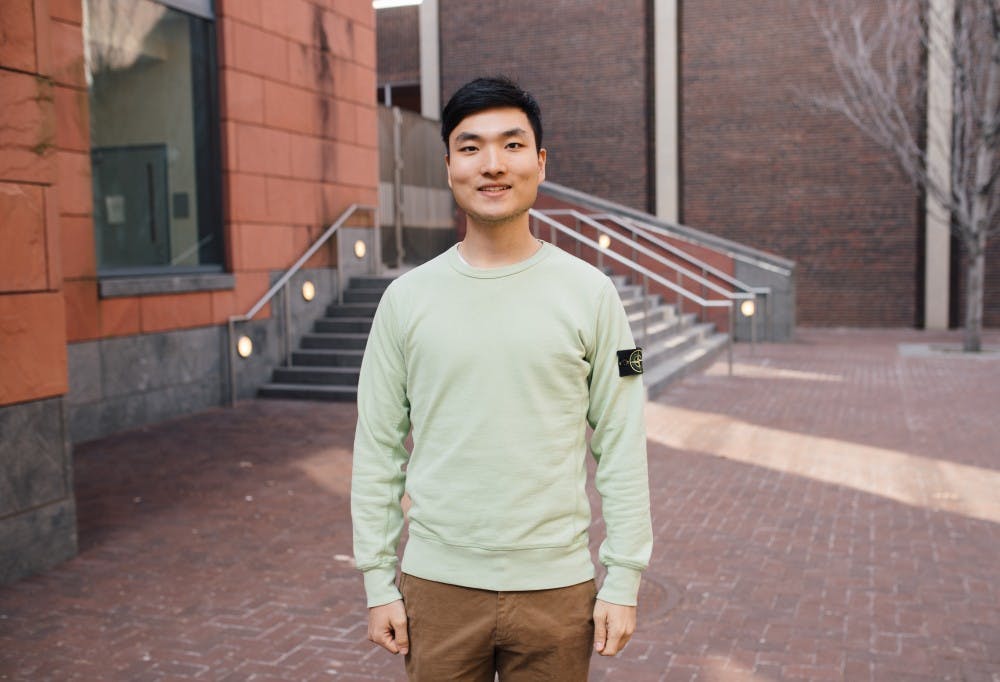
Junney Kang, Army ROTC
When asked about the values that ROTC instills in students, Kang and Stinger rattle off qualities—integrity, trust, leadership, discipline, and responsibility. As Stinger puts it, “If you’re setting up an assault and the bad guys start shooting at you, you have to know what to do.”
ROTC relies on rankings—including peer rankings—to make decisions. While some may think this breeds rivalry, Kim and Blend characterize their community as extremely supportive. “It’s not a competitive thing where ‘I don’t want to help you because I want a better flight ranking.’ You’re a team—that’s so important in the military,” says Kim.
As Bracknell says, the down–to–earth atmosphere of service is humbling, “especially at a place like Penn where you can get super caught up in the pre–professionalism and competitiveness.”
This collective mindset is apparent in the close–knit group of ROTC cadets and midshipmen. One of the first things Blend does in his interview is pull up a picture of what his hair looked like before he joined ROTC. His previous loose “hockey flow” is a sharp contrast from his current close–cropped military cut. Sharing these before–and–after transformations serve as a ROTC bonding experience, he chuckles. Upon meeting, everyone “pulls out pictures of their hair, and we all compare.”
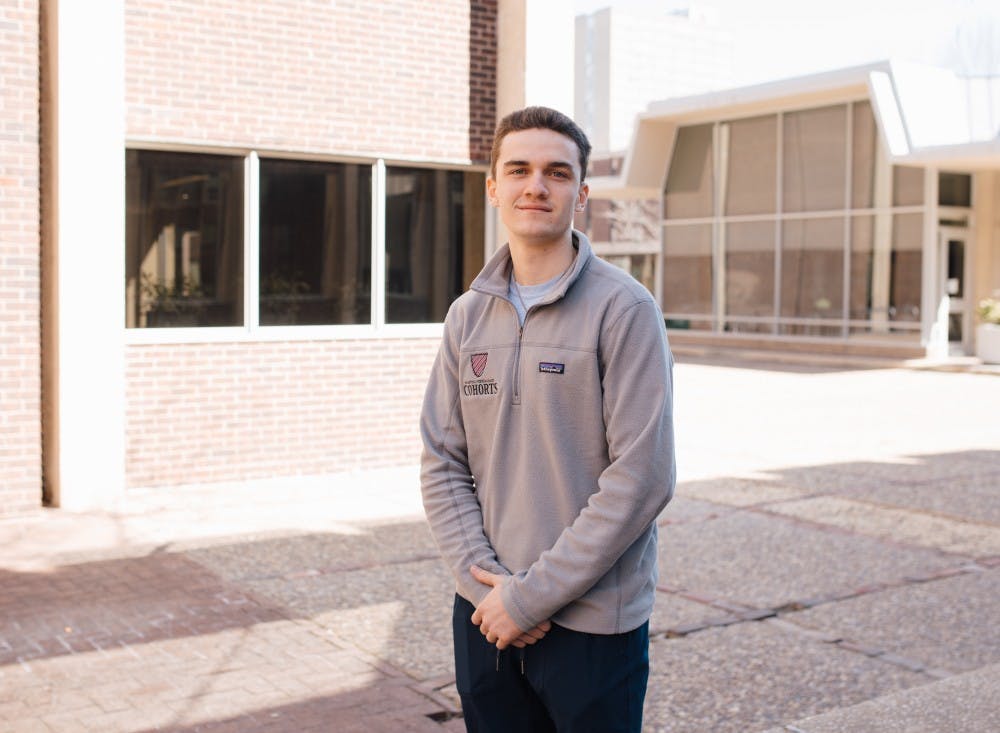
Connor Blend, Naval ROTC
The majority of ROTC activities take place in the early morning. Mondays for Bracknell mean physical training (PT) from 7 to 8 a.m. and then a Naval Science class from 8:30 to 10 a.m. On Wednesdays, the ceremonial NROTC Color Guard Team occupies her from 6 to 7 a.m. After that, she attends Leadership Laboratory, a workshop meant to build leadership and military knowledge, until 8:30 a.m. The same Naval Science class tops off her morning. “[ROTC] forces you to always be at the top of your game. You have to be up early, you have to be able to go to PT twice a week, you have to be able to do well in your classes, because if you don’t do well in your classes, you could lose your scholarship,” Bracknell says.
But beyond their morning duties, ROTC students operate much like regular Penn students. In the free time they do have, they party, they sleep in, and they’re part of student groups. Some of Stinger’s best friends on campus come from his lightweight rowing team, and he spends more time with them than he does with ROTC students.
Bracknell comments that even though most of her best friends are from ROTC, if she didn’t have Bloomers to balance them out, she would drive herself crazy. “And the other way around as well,” she quickly adds.
Of course, ROTC responsibilities always linger at the back of their minds. Kim has “Accountability Checks” every Sunday, meant to emphasize how each cadet has to be there for others. As soon as her flight commander sends out a message on GroupMe sometime during the day—“Like this for your Accountability Check!”—she dives to her phone to comply, no matter where she is.
On top of regular Penn courses, ROTC students also take classes each semester on military science, history, navigation, and more. Bracknell notes that her ROTC classes, which are taught by her unit’s officers, are similar to her Penn courses. “The biggest difference is that [my course materials] are things that I know I’m gonna have to do in the future… It gives you a little bit more motivation.”
Stinger’s classes, in addition to lectures, also focus on practical exercises. On Thursdays, “we’ll saddle up with our 35–pound rocks, go over to Fairmount Park across the Schuylkill and do some ambushes and raids.”
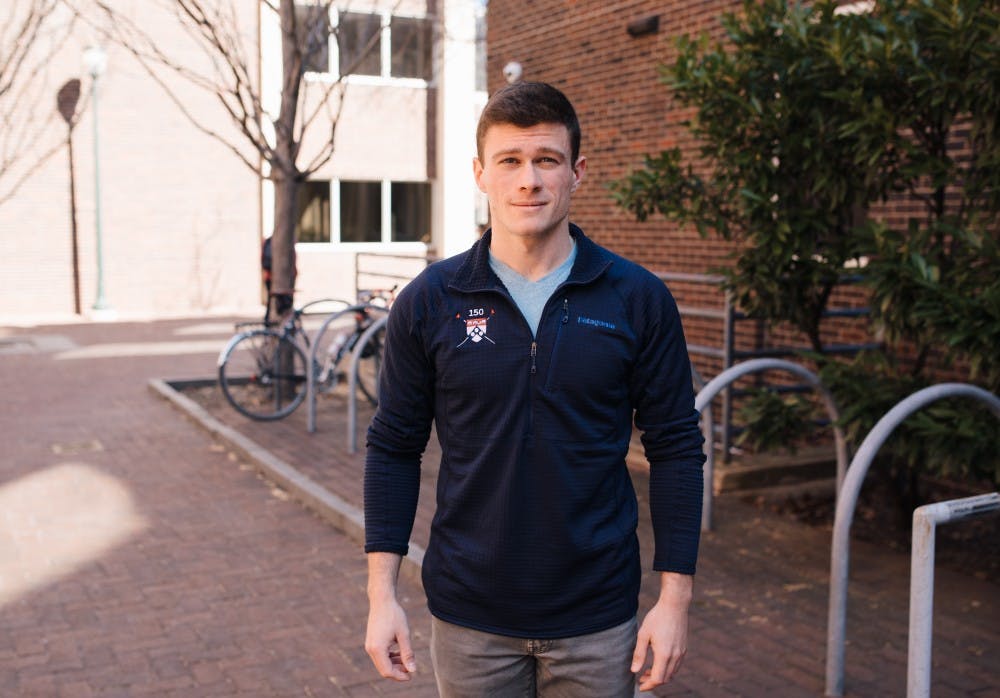
Jack Stinger, Army ROTC
Kim, however, finds that her ROTC classes are “totally” different from the Penn curriculum. If cadets are unprepared, there are consequences, including collective punishment. “Last semester, I messed up on an oral Warrior Knowledge quiz. Because I messed up, my whole flight was yelled at because of me! We got our name changed from Bravo Flight to No Name Flight. I felt so much responsibility—because of me, my whole flight had to suffer,” Kim recounts.
ROTC students are not insulated from many of the problems that have historically plagued the military, including gender bias. While women make up 51.4% of the general population at Penn, in Bracknell’s class of sophomore midshipmen, there are 17 men and only six women. Even in their interviews, ROTC students often use the broad term “boys” or “men” when referring to groups.
“There are definitely challenges that you experience innately, being a woman in the military,” begins Bracknell. “Although the guys generally—very generally—do a good job of making us feel welcome, you’re definitely aware of it all the time. I do notice when I’m the only girl in a group, and I do feel like I have to regulate myself in things that I say, or the way in which I portray myself.”
This inequality even manifests itself in seemingly mundane aspects of ROTC, like uniforms. “They cut them for women, and the person who cut them obviously doesn’t know what a woman’s body looks like. My khaki pants literally touch my top rib. It’s absurd. I can’t tie my shoes when I have my pants on...We look like kangaroos.” She mentions that womens’ shorts needed for uniforms only just started being made.
Bracknell uses this added difficulty as motivation and also as preparation for the future. “The girls learn that when you enter the fleet, there are going to be people who will underestimate you and who will believe that because you are a woman, you cannot be as capable of leading and serving as well as a man could… That motivates me even more to say ‘Okay, I know people are going to underestimate me, so I’m going to prove them wrong.’”

ROTC changes those who pass through it, transforming its members from high school graduates to officers leading troops. Beyond practical or physical training, its cadets and midshipmen are integrated into a culture of service and teamwork, and are placed on a predefined path that will shape both their time at Penn and their life post–graduation.
“It’s alleviating—I have a guaranteed job. But at the same time, it’s a little bit worrying. Because I know that the next nine years of my life are planned out,” Blend says.
Still, he doesn’t regret his decision. “I came in thinking I was going to be the best, and then I realized that it’s not about that at all. The military is a team. Every single person in ROTC, I consider my brother and sister.”
Srinidhi Ramakrishna is a freshman in the College from Montgomery, New Jersey. She is a features staff writer for Street.
